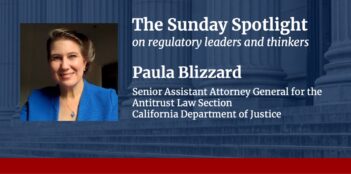
Former government officials discuss how agencies achieve compliance goals by using leverage against companies.
Imagine you are the head of a multibillion-dollar megacorporation. Your task? Finalizing the deal of your career to acquire a slightly smaller, multibillion-dollar megacorporation. What would you be willing to do to get the job done?
In a recent paper, George Washington University Law School Professor William E. Kovacic and Georgetown University Law Center Professor David A. Hyman explain how federal agencies use a strategy called “regulatory leveraging” to capitalize their gatekeeping powers against companies. At its core, regulatory leveraging involves conditioning the compliance that companies seek—such as merger approval—on the settlement of separate and distinct regulatory issues.
Although the authors note that regulatory leveraging injects procedural efficiency into a costly, high-stakes arena, they warn that this strategy “also involves real risks and disadvantages,” such as obstruction of the mergers market. At the end of their paper, Kovacic and Hyman propose a series of recommendations that address these concerns.
Regulatory leveraging is used in many agencies, but Kovacic, a former Federal Trade Commission (FTC) Chair, and Hyman, a former special counsel to the FTC, highlight how the FTC uses the tool in merger reviews. The current merger process is governed under the Hart-Scott-Rodino Antitrust Improvements Act of 1976 (HSR). Kovacic and Hyman explain that the HSR and similar laws have helped replace most traditional merger-related litigation with modern negotiated settlements that have clear resolutions.
Given the fierce competition over target companies in the mergers market, the authors determine that the merger approval process is “tailor-made for the exercise of regulatory leverage, since firms prefer an expedited resolution, and are willing to make concessions to accomplish that goal.”
In one case study, Kovacic and Hyman point to an FTC press release about Robert Bosch GmbH’s acquisition of SPX Service Solutions (SPX). In the press release, the FTC announced how Bosch’s proposed acquisition of SPX—a transaction that would result in “a virtual monopoly in the market for air conditioning recycling, recovery, and recharge devices”—was resolved through Bosch’s sale of its automotive air-conditioner repair business and an agreement to discontinue select SPX contracts.
Yet the press release also documented the resolution of a separate patent-related regulatory dispute with SPX—a textbook case of regulatory leveraging. Although Kovacic and Hyman concede that the FTC press release does not reveal how these two separate issues were jointly resolved, the authors do argue that it was “a package deal.”
“No one at the FTC has to say ‘nice merger you’ve got there; it would be a shame if anything was to happen to it,’” Kovacic and Hyman argue. They simply conclude that those seeking merger approval “understand how the game will be played.”
The FTC’s use of regulatory leveraging did not go unnoticed. In an article posted weeks after the FTC’s press release, Leon Greenfield, a partner at WilmerHale, stressed that the Bosch case illustrates that the FTC may use merger review to scrutinize other company practices that are not involved in the merger. Consequently, Greenfield advised that merging parties should identify and be prepared to defend any practices that could fall under the FTC’s scrutiny during a merger investigation. Kovacic and Hyman note that the FTC has the authority to conduct these investigations during merger review.
So who wins when regulatory leveraging is used?
Kovacic and Hyman claim that regulatory leveraging benefits both federal agencies and merging companies. Most notably, they argue that regulatory leveraging “promotes more comprehensive settlements,” which helps both parties by forgoing independent, costly inquiries.
Yet, the authors list numerous disadvantages that accompany this sort of deal-making. The authors’ primary concern focuses on the tradeoff between procedural efficiency and upholding the process and substance of antitrust law.
This tradeoff is especially critical within the merger context, Kovacic and Hyman explain, because merger review is often addressed outside of courtrooms, where negotiations are less visible to criticize. Further, they claim that settlement agreements are rarely subject to appeal. Since negotiations in merger reviews are firm-specific and vary depending on the officials in charge of reviewing the merger, the authors conclude that the resulting combination of less transparency, accountability, and disputability could “imped[e] the development of a robust market for mergers and acquisitions.”
A similar concern for transparency emerged in FTC Commissioner Maureen K. Ohlhausen’s dissenting statement about the Bosch case, where her strong disproval focused on the FTC’s authority to dispute the ancillary SPX matter.
To address some of these concerns, Kovacic and Hyman spell out several solutions.
First, the authors argue that, if regulatory leveraging is a desirable tool to have, Congress should openly sanction its use. According to the authors, this would include identifying boundaries, such as time limits on how long regulators can delay regulated companies and limitations on negotiating for concessions that are beyond an agency’s authority.
The authors then contend that agencies should be transparent about when they use regulatory leveraging so its use can undergo constructive criticism. The authors also briefly suggest that regulatory leveraging should only be used as a backup method of solving policy problems until the potential for its abuse is mitigated.
Lastly, the authors recommend that an investigation should be done to determine how often regulatory leveraging is used, how effective it is, and its constitutionality—noting that more research on the matter could only be beneficial.
Although Kovacic and Hyman warn that, “[u]nless properly disciplined, regulatory leveraging becomes lawlessness,” they conclude that instilling the proper discipline will not be “a simple fix.”
In the future, Kovacic and Hyman intend to release a follow-up paper on how private parties turn the tables and use leverage against regulators.



